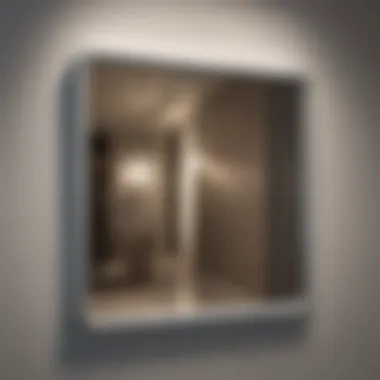Top Wall Hangers for Heavy Objects: A Complete Guide


Intro
In today’s diverse living environments, the need for secure and aesthetically pleasing ways to display heavy objects has never been greater. Whether it’s an oversized painting, a collection of vintage firearms, or a large decorative mirror, selecting the right wall hanger is crucial for both safety and style. This guide delves into the best options available, tailored specifically for heavy objects. We will cover various materials, load capacities, and installation methods that meet the demands of discerning homeowners and design enthusiasts alike.
Hanging heavy items can often be a daunting task. Improperly installed hangers not only risk damaging the object itself but also pose significant hazards in the home. Therefore, understanding the mechanics of weight distribution and wall support systems is essential. Our exploration will provide you with a wealth of knowledge that allows for informed decision-making and proper execution of your interior design goals.
Featured Homes
Architectural Highlights
In homes known for their exquisite architectural elements, wall hangers must complement these features while preserving the integrity of both the structure and the displayed items. Consider homes with high ceilings and expansive walls, often found in contemporary or industrial designs. In such spaces, utilizing heavy-duty wall hangers ensures that artwork or functional pieces remain securely mounted, allowing the design to speak for itself without compromise.
Interior Design Themes
Today's interior design trends showcase a fusion of traditional and modern styles. Wall hangers play a significant role in this integration. For instance, in a rustic theme, wrought iron brackets can beautifully support heavy wooden shelving. Meanwhile, in minimalist spaces, sleek metal mounts help maintain a clean profile while carrying significant weight. Choosing the right wall hanger thus becomes not just a question of function, but also one of style that can elevate the overall aesthetic.
Choosing the Right Type of Hanger
Selecting the appropriate wall hanger for heavy objects involves assessing various factors. These include the weight of the item to be hung, the material of the wall, and the expected load capacity of the hanger. Here are some types worth considering:
- D-ring hangers: Perfect for pictures, these offer straightforward installation and are very secure.
- Heavy-duty picture hooks: These can handle considerable weights and are suitable for artworks.
- Wall anchors: Ideal for drywall, these expand within the wall to support larger objects.
Choosing the correct wall hanger is essential for not just aesthetic appeal, but also for safety and durability.
End
Prelims to Wall Hangers
Choosing the right wall hangers is a fundamental task for anyone who wishes to display heavy objects securely and effectively within their spaces. Wall hangers are essential tool used to support pictures, mirrors, shelves, and other decorative items. Their correct selection ensures not only that these items are safely anchored to the wall, but also that they maintain the desired aesthetic without compromising the wall's integrity.
Importance of Choosing Correct Wall Hangers
The importance of selecting the right wall hangers cannot be overstated. Improper hangers can lead to accidents, costly damage, and frustration. When heavy objects are involved, the stakes are even higher.
- Safety: The first consideration must always be safety. Using inappropriate hangers can result in items falling, leading to potential injuries and damages. For example, a large mirror secured with inadequate hardware could easily become a hazard.
- Weight Capacity: Each wall hanger has a specific weight capacity that determines how much weight it can bear safely. It is crucial to check this before selecting a hanger. Using a product that cannot support the weight of the object means risking failure.
- Wall Compatibility: Another critical aspect is the compatibility of the hangers with different wall types, such as drywall, plaster, or concrete. Various materials may require different hanging hardware to be effective.
- Aesthetic Consideration: Lastly, the wall hanger should not only perform well but also complement the overall design of the room. The choice of color and style can enhance or detract from the intended look of any space.
General Applications of Wall Hangers
Wall hangers are diverse in their applications, designed to fit a broad range of heavy items in various environments.
- Home Decor: In residential settings, wall hangers are commonly used for artwork, mirrors, and shelves.
- Office Settings: In professional environments, they secure presentations and motivational materials on office walls.
- Public Spaces: In museums or galleries, specification for secure wall hangers is crucial for exhibiting valuable and often heavy artifacts.
For every function, a proper wall hanger choice can lead to the distinction between a successful installation and a mishap. Thus, understanding the fundamentals of wall hangers before even making choices about decor can save time and ensure safety.
Types of Wall Hangers for Heavy Objects


Selecting the right type of wall hanger is essential when dealing with heavy objects. The chosen hanger impacts not only the safety and security of your items but also affects the overall aesthetic of your space. Each type of wall hanger serves specific functions and provides distinct benefits based on the items being hung and the nature of the wall. It's crucial to understand the variety of options available so that you can make informed decisions tailored to your needs.
The Functionality of D-Ring Hangers
D-ring hangers are a popular choice for many homeowners. This hardware consists of a metal ring that is attached to a triangular plate, allowing for secure mounting. Their primary advantage lies in their ease of installation. D-ring hangers can support a substantial amount of weight, depending on their size and the type of screws used. They offer a stable solution for picture frames, mirrors, or artwork.
When hung properly, D-ring hangers distribute weight evenly across the wall, minimizing damage to drywall or plaster. It's advisable to use two D-rings when mounting larger items. This approach provides added stability and keeps the object level, which is essential for aesthetic reasons.
Exploring Keyhole Wall Hangers
Keyhole hangers feature a slot that allows the mounting hardware to fit neatly into place. This type of hanger is especially advantageous for wall art and décor items, as it creates a flush and clean profile against the wall. The installation process involves securing the keyhole plates to the wall and ensuring that they are level.
One of the main benefits of keyhole anchors is that they can handle considerable weight when installed correctly. This makes them suitable for larger frames and heavier items. Additionally, the design provides a hidden fastening method, enhancing the visual appeal of the hanging piece.
Understanding Toggle Bolts
Toggle bolts are ideal for hanging heavy items on drywall without studs. Their design allows the bolt to expand behind the wall, creating a secure hold even for objects weighing significant amounts. When considering toggle bolts, inspect your wall composition—drywall alone may not support heavier loads without these specialized anchors.
Installation requires drilling a hole large enough for the bolt to pass through. Once inserted, the wings of the toggle open and grip the back of the drywall. This method provides excellent support for items like large mirrors or cabinets, but the installation process can be slightly more complex than other types of wall hangers.
The Versatility of French Cleats
French cleats provide a versatile and robust solution for hanging heavy objects. This system consists of two interlocking pieces; one is mounted on the wall, while the other is attached to the item being hung. This allows for easy adjustment and leveling of the displayed object.
An advantage of using French cleats is their ability to support a wide range of weights and sizes. They are often preferred in commercial applications, such as securing cabinets, but they work equally well in residential settings for heavy artwork or shelving. This system also helps distribute weight evenly, reducing the risk of wall damage.
Analyzing Heavy-Duty Adhesive Strips
While adhesive strips may not provide the same level of support as traditional hangers, they are an option worth noting for lightweight items. Heavy-duty adhesive strips, such as those from 3M, can hold significant weight when used correctly. They are ideal for renters or those who do not wish to drill holes in walls.
Before using adhesive strips, ensure that the wall is clean and dry. Adhering to the manufacturer’s instructions is crucial for optimal performance. These strips are not suitable for all objects, and heavier items may risk falling. Therefore, they are best suited for lighter decorative pieces or tools.
Comparing Wall Anchors
Wall anchors come in various forms, including plastic expansion anchors and metal screw-type anchors. The choice of wall anchor depends on the weight of the object and the wall material. For instance, metal anchors provide more strength, suitable for heavier items on drywall. Plastic anchors can suffice for light to moderate loads.
When installing wall anchors, it is essential to drill a hole compatible with the anchor size. The performance of an anchor largely depends on how well it is fitted within the wall. Evaluating the specific requirements of the hanging object will ensure that the most effective anchor type is employed.
Proper selection and installation of wall hangers can significantly enhance the safety and aesthetics of your space.
Criteria for Selecting Wall Hangers
When it comes to selecting wall hangers for heavy objects, there are several vital criteria to consider. The right hangers will not only ensure safety and stability but also affect the overall appearance of your mounted items. Each criterion plays a key role in determining the most suitable option for your needs, thus making it imperative to assess them thoroughly before making any purchasing decisions.
Assessing Weight Capacity


Weight capacity is arguably the most crucial factor when selecting wall hangers. Each type of hanger is rated for a specific maximum load, which must be adhered to for safety reasons. Ignoring this rating can lead to disastrous consequences like falling objects or damage to the wall itself.
A prioritization of weight assessment can include the following:
- Know the item weight: Weigh your item or check its specifications.
- Account for additional factors: Consider if accessories or elements like frames could add to the overall weight.
- Choose appropriately rated hangers: Select wall hangers that support considerably more than your item's total weight for an extra margin of safety.
Understanding Wall Material Compatibility
Wall material compatibility is essential for ensuring that the wall hangers used will function correctly without compromising wall integrity. Not all wall hangers work with every wall type. Here are some common materials you might encounter:
- Drywall: Many common wall hangers are designed specifically for drywall. Toggle bolts or anchors often work well here.
- Concrete or brick: Requires heavier-duty solutions like masonry screws or specialized anchors.
- Wood: Standard screws may suffice but ensure they are thick enough to hold the weight levels intended.
Knowing your wall material allows you to choose the right hardware and increase the chances of a successful installation.
Evaluating Installation Complexity
Installation complexity can vary greatly from one hanger type to another. Understanding how complex the installation process will be is critical in determining your choice. It may involve tools, technical skills, or time to set things up. For example:
- D-Ring Hangers can often be installed with just a simple screwdriver.
- Toggle Bolts require more effort and possibly drilling, making them a less favorable choice for some.
Before you choose your hangers, assess your own capabilities and the tools you have at hand. Sometimes, hiring a professional can save time and ensure safety.
Considering Aesthetic Integration
Lastly, aesthetic integration should not be overlooked. Choosing wall hangers that align aesthetically with your decor can enhance the overall look of your space. Consider the following:
- Color and finish: Select hangers that blend in with the wall or complement the item being hung.
- Visibility: Some wall hangers are more visible than others, so choose ones that work with your design goals.
- Style: Consider modern versus traditional styles depending on your room.
Installation Practices
The installation of wall hangers for heavy objects is an essential aspect of the overall project of securing decor. Proper installation not only maximizes the safety and functionality of the hangers but also ensures aesthetic appeal. Each type of wall hanger has distinct installation techniques and requirements, which makes understanding these practices critical. Following the right installation protocol can help avoid common mistakes, enhance the longevity of the fixtures, and protect the integrity of the walls themselves. This section will delve into tools needed, a step-by-step guide for proper installation, as well as vital safety precautions.
Tools Required for Installation
When preparing to install wall hangers, having the right tools at hand can significantly streamline the process. Here are the essential tools you will typically need:
- Drill: This is needed for creating pilot holes, especially for hangers that require screws.
- Screwdriver: A versatile tool, used for fastening screws securely into walls.
- Level: An important instrument for ensuring that the item is perfectly horizontal or vertical when installed.
- Tape Measure: For measuring distances accurately to position the hangers correctly.
- Wall Anchor Kit: This is necessary for situations where drywall or other materials cannot hold weight directly.
- Pencil: Used for marking positions on the wall before making any holes.
- Safety goggles: Always important to protect your eyes during work.
Having these tools ready eliminates delays and mistakes during the installation, leading to a successful setup.
Step-by-Step Installation Guide
Installing wall hangers properly does not have to be daunting. Here is a straightforward guide to help you through the process:
- Choose the Right Location: Select where you want your object to hang and mark the spot with a pencil.
- Use the Level: Ensure that your markings are even; this step is crucial to the visual appearance.
- Check Wall Material: Before drilling, confirm the wall material to select the appropriate wall anchors.
- Drill Pilot Holes: If required, drill small holes according to the size of the wall hangers you are using. Remember to choose the drill bit compatible with your wall.
- Install Wall Anchors: Insert any necessary wall anchors into the pilot holes.
- Secure Hangers: Fasten the wall hangers in place, using the screwdriver to make sure they are tight and secure.
- Hang Objects: Finally, hang your art or other heavy items according to the hangers you have installed.


Completing these steps will offer not only a secure installation but also give you assurance in the weight-bearing capabilities of the wall hangers.
Safety Precautions During Installation
Safety should never be compromised during installation. Here are some key precautions to consider:
- Wear Protective Gear: Always put on safety goggles and gloves. This protects against debris while drilling.
- Check Existing Wiring and Plumbing: Before drilling into walls, ensure there are no hidden wires or pipes where you could potentially cause damage or injury.
- Use Correct Ladders or Stepladders: When reaching high places, using a sturdy ladder is vital to prevent falls.
- Have an Extra Pair of Hands: For larger objects, enlist a partner to help. This avoids accidents when lifting heavy items.
- Follow Manufacturer Instructions: Adhering to the guidelines provided by the manufacturer of the wall hangers is critical for safety and effectiveness.
By taking these safety measures, you can protect yourself and ensure a safe installation process.
"Proper installation of wall hangers ensures not just functionality but longevity and safety for your cherished objects."
Problematic Scenarios and Solutions
The section on problematic scenarios and solutions holds significant relevance in the context of wall hangers for heavy objects. Selecting the right wall hanger is not solely about understanding product specifications but also addressing potential issues that can arise during installation and usage. Mistakes made at this stage can lead to serious consequences. This part of the article serves to equip readers with foresight into common problems and actionable solutions. By highlighting pitfalls and their solutions, homeowners and design enthusiasts can avoid costly repairs and ensure their decor remains secure and intact.
Common Installation Mistakes
Installation is crucial when it comes to ensuring a wall hanger's effectiveness. Many common installation mistakes can lead to improper securing of heavy objects. Here are some frequent errors:
- Neglecting to Use Stud Finders: Many homeowners try to anchor hangers directly into drywall without checking for studs. This can compromise the weight-holding capacity of the hanger, leading to failures.
- Overtightening Screws or Bolts: Some individuals may mistakenly believe that the tighter they fasten a screw, the stronger the hold. Over-tightening can strip screws and weaken the integrity of the wall fixture.
- Ignoring Manufacturer Instructions: Each wall hanger comes with specific guidelines regarding installation. Ignoring these can lead to incorrect procedures.
To avoid these mistakes, always check wall anatomy using a stud finder before beginning. Follow the installation instructions carefully to ensure the maximum weight capacity is achieved.
Addressing Wall Integrity Issues
Wall integrity is a foundation upon which the durability of a wall hanger lies. Weak or damaged walls can significantly compromise a hangers’ effectiveness. Here are some wall integrity issues:
- Drywall Damage: Holes from prior installations or water damage can reduce the wall's capacity to hold weight.
- Cracks or Weak Spots: Inspect the wall for any cracks which can indicate a deeper structural issue.
- Inadequate Wall Material: Certain materials are better suited for heavy objects. For instance, plaster walls may not hold as securely as concrete.
To address these issues, consider reinforcing the wall with additional support where needed. If damage is present, it might be wise to repair the wall before installation. Using appropriate anchors specific to the wall material will also provide enhanced support.
Resolving Weight Distribution Problems
Weight distribution plays a pivotal role in how well a heavy object is secured on a wall. Improper distribution can lead to strain on a single point, challenging the durability of the wall hanger. Here are ways to manage weight distribution effectively:
- Evenly Distributing Weight: When hanging multiple items, spread out the weight to avoid overloading a single point. This can be managed by planning the layout before installation.
- Using Multiple Hangers: For exceptionally heavy items, utilize more than one hanger to distribute the load evenly across the wall.
- Adjusting Height and Positioning: Sometimes, the height at which an object is hung can lead to strain on one end. Ensuring that the center of mass is accurately positioned can mitigate this risk.
Taking these measures into account will greatly enhance the longevity and reliability of the wall hangers used. A well-planned approach to handling these scenarios leads to a more secure display of heavy objects.
Culmination
Summary of Key Points
- Selection Criteria: Always consider weight capacity, wall material compatibility, installation complexity, and aesthetic integration when selecting wall hangers. Each factor plays a critical role in ensuring that the chosen method adequately supports the intended load.
- Types of Hangers: The options discussed—such as D-ring hangers, keyhole wall hangers, toggle bolts, French cleats, heavy-duty adhesive strips, and wall anchors—each offer different advantages and suit various contexts. Knowledge of these types can simplify the decision-making process.
- Installation Practices: Proper installation practices must be adhered to, focusing on the tools needed, a step-by-step installation guide, and critical safety precautions. Poor installation can lead to catastrophic failure, damaging both the object and the wall.
- Problem-solving: Address common issues like installation mistakes, wall integrity, and weight distribution problems effectively with the right solutions, ensuring a successful setup each time.
Final Recommendations
To maximize the effectiveness of your wall hangers:
- Choose Wall Hangers Wisely: Understand the specific requirements of your objects and the wall types where they will be installed.
- Prioritize Installation Skills: If you're unsure, consider hiring a professional to avoid common mistakes.
- Regularly Assess and Adjust: Check the hangers periodically, particularly if heavier items are added or if there are signs of wear.
- Stay Informed About New Products: The market frequently sees innovations; keep abreast of developments in wall-hanging technology to enhance security and ease of use.
In essence, selecting wall hangers for heavy objects extends beyond mere choice. It is about achieving a balance between style and safety, ensuring an optimal environment for displaying cherished items.







